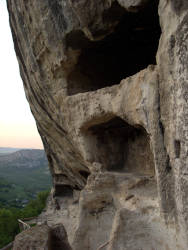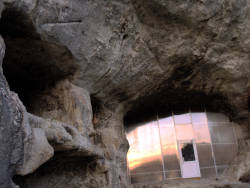Челтер-Коба
Chelter-Koba
Useful Information

| Location: |
Малосадовое (Malosadovoe).
(44.6310160, 33.8311028) |
| Open: |
no restrictions. [2024] |
| Fee: |
free. [2024] |
| Classification: |
 Cave Church Cave Church
|
| Light: | n/a |
| Dimension: | |
| Guided tours: | self guided |
| Photography: | allowed |
| Accessibility: | no |
| Bibliography: | |
| Address: |
Монастырь св. вмч. Феодора Стратилата, Малосадовое, Tel: +7-9787211080.
E-mail: |
| As far as we know this information was accurate when it was published (see years in brackets), but may have changed since then. Please check rates and details directly with the companies in question if you need more recent info. |
|
History
| 1475 | monastery destroyed when the Turks invaded Crimea and occupated the Principality of Theodoro. |
| 2000 | monk Daniel settles in the abandoned monastery with the blessing of Bishop Lazar, Metropolitan of Simferopol and Crimea. |
| 2002 | services resumed. |
| 2012 | pilgrimage hotel opened on the monastery courtyard. |
| 2015 | declared a cultural heritage site of federal significance. |
Description


Челтер-Коба (Chelter-Koba) is also known as Монастырь Святого Феодора Стратилата (Monastery of St. Theodore Stratilates) or in Ukrainian пещерный монастырь «Ай-Тодор» (cave monastery “Ai-Todor”). As the name says, it is one of the many cave monasteries on Crimea, and belongs to the Simferopol diocese of the Russian Orthodox Church. The name Chelter-Koba, “chelter” means “lattice”, “koba” means “cave”, was given to the site by the Tartars because all the caves were connected by wooden stairs at that time. It is located in Belbek river valley, 1 km from the village of Malosadovoye.
It seems there is much unclear about this monastery. Probably a result of the fact that it was destroyed during a Turkish invasion in 1475. Some sources say it was founded in the 13th or 14th century, others say it was founded in the 8th or 9th century. Undisputed is that it was dedicated to the Great Martyr Theodore Stratelates, who lived in the 3rd century. The name was preserved as an inscription on the rock.
The monastery is a series of rectangular caves which were cut into the limestone cliff of the escarpment. The small caves are cells, where the monks lived. Probably the monastery started as a series of hermits’ cells. A huge cave contains the church. At the far end is a small spring, which is considered to produce healing water.
Since 2000 restauration of the site has started. The church has been restored with a staircase, a new altar, a bell tower in front, and a glass wall with a door which closed the portal. Even some cells were restored. In other words, this site is a place of worship again.
 Search DuckDuckGo for "Chelter-Koba Cave Monastery"
Search DuckDuckGo for "Chelter-Koba Cave Monastery" Google Earth Placemark
Google Earth Placemark OpenStreetMap
OpenStreetMap Челтер-Коба - Wikipedia (visited: 24-JUN-2024)
Челтер-Коба - Wikipedia (visited: 24-JUN-2024) Монастырь св. вмч. Феодора Стратилата, official website
Монастырь св. вмч. Феодора Стратилата, official website  (visited: 24-JUN-2024)
(visited: 24-JUN-2024) Index
Index Topics
Topics Hierarchical
Hierarchical Countries
Countries Maps
Maps